
I feel a bit sorry for Albert Moore. If you asked someone to name drape-y painters of Victorian England, Moore would come third, if he was lucky. It often takes an exhibition for me to give more consideration to an artist who is often rather overlooked in the grand scheme of things and this is definitely the case for Moore. If I thought it was going to be all lovely drape-y ladies, I was much mistaken...
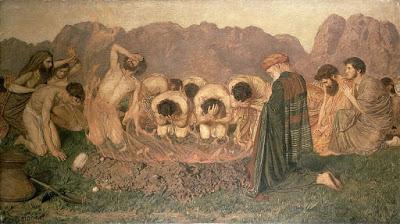
Elijah's Sacrifice (1863)
He wasn't always all about the drape, you know. When he started, Moore did large scale Biblical scenes, possibly with an eye to the Bible market (that was a pretty hefty market). His early work, such as Elijah's Sacrifice bears more resemblance to TM Rooke or Edwin Longsden Long (whose paintings are very long indeed). There's a bit of drape, certainly, but it feels wrong to appreciate the drape when there is so much Biblical misery and stuff going on. The fire is absolutely stunning though - weird, fragile, unnatural yet terrifying.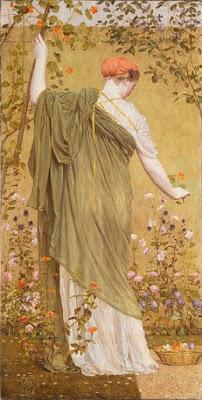
A Garden (1869)
Okay, so there are a goodly number of drape-y ladies and they are pretty glorious. A Garden is large and graceful, the woman almost one of the plants in the garden in both form and colouring.
Azaleas (1867-8)
Azaleas was Moore's first large-scale, subjectless piece. Swinburne commented 'The melody of colour, the symphony of form is complete. One more beautiful thing is achieved, one more delight is born into the world; and its meaning is beauty; and its reason for being is to be.' The exhibition is undoubtedly packed to the gunnels with these women, tending plants, swaying in their sun-drenched courtyards, collapsing in the heat. Some are large, but the ones I really loved were small, tiny gems of detail and precision...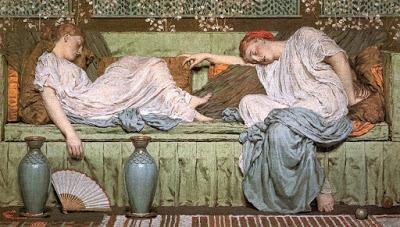
Beads (1875)
Beads is a very beautiful little picture. It is also a clue to why Moore might not be taken so seriously. Whilst Beads is a little gem, it's awfully similar to this...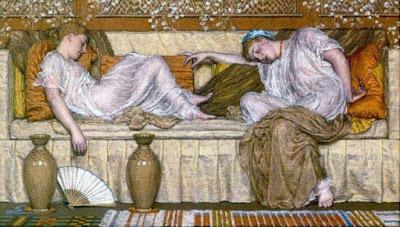
Two Female Figures Reclining on a Sofa (1875)
...oh, and this one...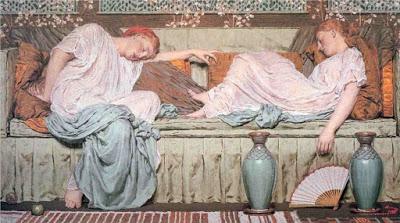
Apples (1875)
One complaint I hear about Moore is that he can be 'same-y' and when grouped together you can see how he took advantage of a nice piece of composition and tone. I also love the idea that Moore took advantage of his models' rest time to continue sketching them. However, if the York exhibition shows us anything, it shows that Moore was far more than floppy ladies on sofas...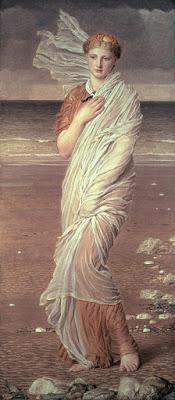
Shells (1874)
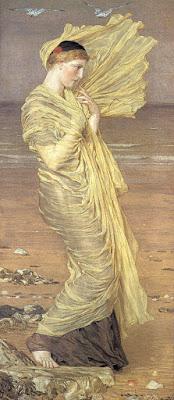
Sea Gulls (1870-1)
I really loved the blow-y pictures, which reminded me of certain works by Waterhouse. If you think about how difficult it must have been to catch a realistic flutter of fabric, the realistically awkward wrap of the shawl around the model's head seems like a real moment captured. Equally as staged as the sofa paintings, the swathes of fabric caught in the wind refer back to those discrete wisps that covered the privates of classical types.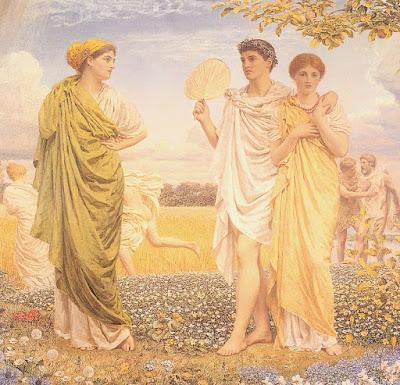
The Loves of the Winds and the Seasons (1893)
An absolute knock-out piece has to be The Loves of the Winds and the Seasons, huge in scale and rich in subject. It reminded me of Agnolo Bronzino's Venus, Cupid, Folly and Time or Botticelli's Primavera, a multi-layered picture filled with drama and detail. On the left we have Summer, and swanning in from the right we have Autumn and her best friend the South Wind (with his fan). All is lush meadow and blooms for them, but in the background, it's a different story. On the right, in snow, the North and East Wind are having a scrap, while Zephr chases Spring behind Summer's back. It's both beautiful and odd all at once, and very large indeed.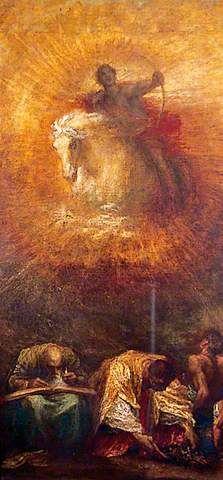
Progress (1888-1904) G F Watts
To add context to Moore, the exhibition also has rooms of his contemporaries and his family. The Moore family were resplendent with artists. William Moore (1790-1851), an artist, moved his family to York around 1830 and of his 14 children, 5 were practicing artists - Edwin, William Jnr, John Collingham, Henry and Albert. Albert was born in York and so the art gallery is a natural setting for him and seeing so many of his works in one place makes you view him in a different way. The context in which he created art, within the same marketplace as Watts, Burne-Jones, and Walter Crane, lifts Moore outside the box of Alma Tadema and Leighton where he has a tendency to be seen as 'the other one'.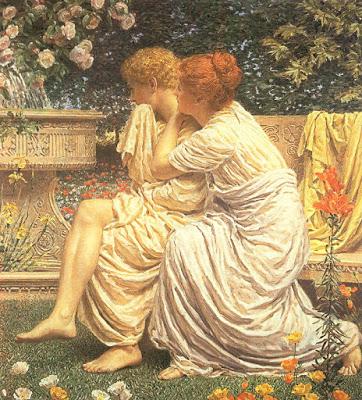
An Idyll (1892)
If this exhibition does anything, it lifts Moore to the front and shows that he is far more than just woman-as-still-life. I really liked seeing his work that strayed from the aesthetic path, and although paintings like Midsummer are breath-taking in their clarity and beauty, The Loves of the Winds and the Seasons are paintings that can be gazed at for ages, seeing different things, the oddness of the snow, the figure of Zephyr who seems to hide from us. Moore deserves to come out of the box and this is the perfect place to see him in all his glory.Albert Moore: Of Beauty and Aesthetics is on at York Art Gallery until October and further details can be found here.

